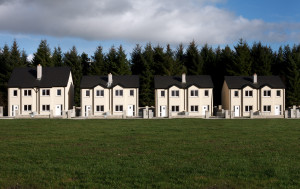Jordan G. Teicher – A Stroll Through Ireland’s Eerie Ghost Estates – Photo’s: Valérie Anex
From the mid-1990s through 2006, home prices in the Republic of Ireland increased steadily, fueled by a period of economic prosperity known as the Celtic Tiger. In 2008, the property bubble burst, and investors who’d built housing developments in remote rural areas found themselves unable to sell their properties or, in many cases, even finish their construction.
Valérie Anex, an Irish citizen who grew up in Switzerland, was in County Leitrim in 2010 when she first came across ghost estates—defined by the National Institute for Regional and Spatial Analysis as a development of 10 houses or more in which 50 percent or less of homes are occupied or completed. Anex was astonished to learn that ghost estates were common all around the country. “The house is an object full of very strong symbols,” she said via email. “It is inevitable that when people discover through my images the existence of these inhabited brand-new houses, they start to ask themselves: What has happened? What are the historical forces that lead to this absurd situation? How is it possible to construct houses if there aren’t any people willing to live in them? Where does this surplus come from? Why this waste of labor, resources and energy?”
Read & see more: http://www.slate.com/val_rie_anex_photographs




